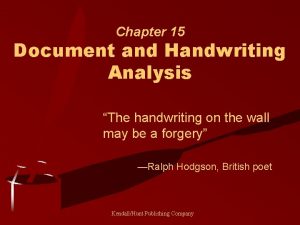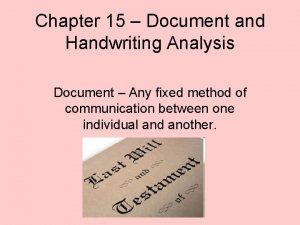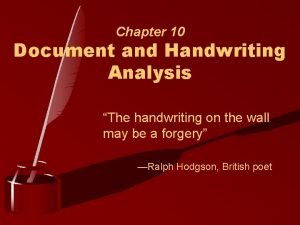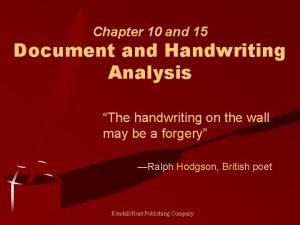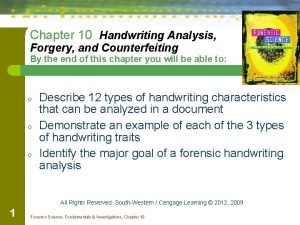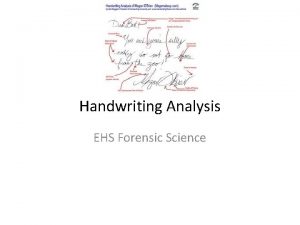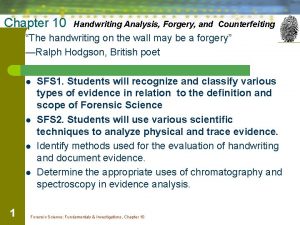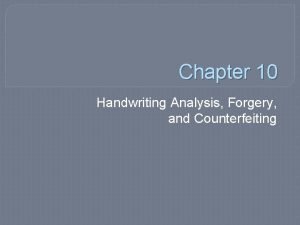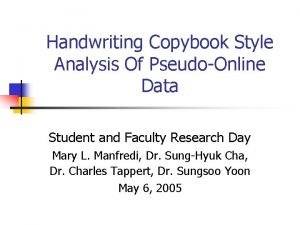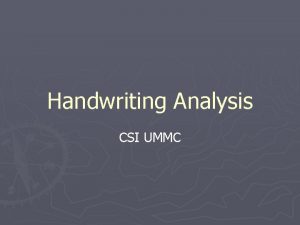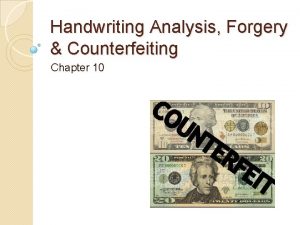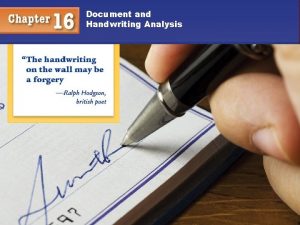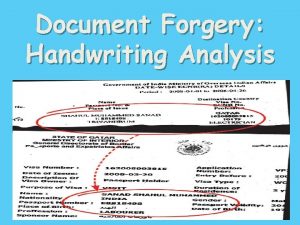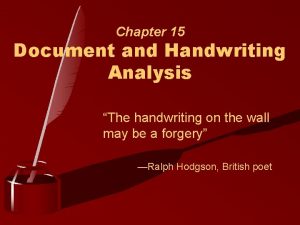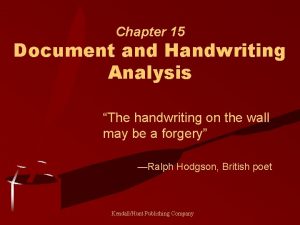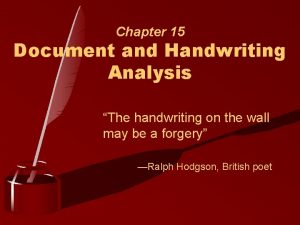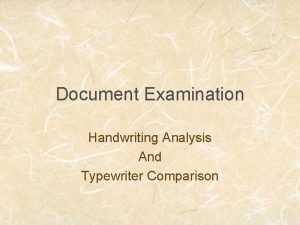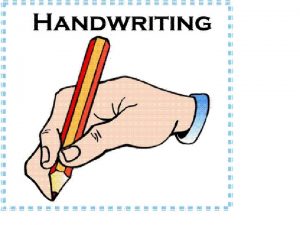DOCUMENT AND HANDWRITING ANALYSIS DOCUMENTS AS EVIDENCE Document













- Slides: 13

DOCUMENT AND HANDWRITING ANALYSIS

DOCUMENTS AS EVIDENCE Document specialists are called to : • Verify handwriting and signatures • Authenticate documents • Characterize papers, pigments, and inks • Restore erased and obliterated handwriting • Determine the relative ages of documents and inks

HANDWRITING ANALYSIS • The primary basis of handwriting analysis as a science is that every person in the world has a unique way of writing. • When we were all kids in primary school, we learned to write based on a particular copybook a style of writing. • Which copybook our handwriting is based on depends on when and where we grew up.

SO, WHY DON’T WE ALL WRITE THE SAME? • As time passes, those writing characteristics we learned in school our style characteristics – are changed as we developed individual characteristics that are unique to us, thereby distinguishing our handwriting from someone else's. • Handwriting experts say that two or more people may share a couple of individual characteristics, but the chance of those people sharing 20 or 30 individual characteristics is nearly impossible.

HANDWRITING ANALYSIS 101 • Handwriting analysts must be able to accurately distinguish between style characteristics and individual characteristics, which takes a lot of training. • The individual characteristics are what matter the most in determining authorship. • By comparing a known author’s written piece with an unknown author, handwriting expects look at the differences, not the similarities, between the two samples.

FORGERY! • If the re are key differences in enough individual characteristics, then the two documents were not written by the same person. • However, if the differences don't rule out a match, and there are significant similarities in the individual traits in the two documents, singular authorship becomes a possibility. • The expert’s job is to turn possibility into probability.

THREE TYPES OF FORGERY • Blind Forgery: made without a model from which to copy • Simulation: made by copying an actual signature or writing sample • Traced forgery: made by tracing a genuine writing sample

DETECTING SIMULATION • Simulation occurs when a person is either trying to disguise his handwriting to prevent the determination of a match or to copy someone else's handwriting to encourage the inaccurate determination of a match. • There are certain traits that analysts look for to determine whether a handwriting sample is the result of simulation. • These include shaky lines, dark and thick starts and finishes for words and a lot of pen lifts, all of which come from carefully, slowly forming letters instead of writing quickly and naturally.

WHAT DO HANDWRITING ANALYSTS LOOK FOR? • Letter form This includes curves, slants, the proportional size of letters, the slope of writing and the use and appearance of connecting lines (links) between letters. • Line form This includes how smooth and dark the lines are, which indicates how much pressure the writer applies while writing and the speed of the writing. • Formatting This includes the spacing between letters and between words, the placement of words on a line and the margins left empty on a page. It also considers spacing between lines do strokes from words on one line intersect with strokes in words on the line below and above it?

INK ANALYSIS • Another way to verify the authenticity of a document is to perform ink analysis. • Non destructive methods include microscopy and luminescence. • Microscopy is used to distinguish the type of writing instrument used and the color qualities of the ink. • Visual or infrared luminescence is used to differentiate between inks. • It can be used to find the original writing on a document that has been obliterated with a different ink or to distinguish sections that have been altered with different inks.

CHEMICAL INK ANALYSIS • Chemical ink analysis requires a short length of a document’s line be removed, which destroys part of the document. • The traditional method for chemical analysis of ink is to use Thin Layer Chromatography (TLC. ) • It involves removing several "plugs" of ink and paper from the document, dissolving the ink in a solvent, and then spotting the dissolved ink onto a piece of filter paper. • The filter paper is suspended over a new solvent with just the tip of the filter paper dipped in the solvent. • The solvent soon migrates up the filter paper, carrying the ink with it. Distinct bands form, based on the physical and chemical composition of the inks.

CRIME RECONSTRUCTION • Rarely can experts identify a specific pen as having written various entries on a document. If inks cannot be differentiated one from another by any of the above examinations, this leaves three possibilities: • The same pen has been used for the entries, or • Different pens containing the same ink have been used for the entries, e. g. two pens from the same manufacturer, or • Different pens have been used for the entries which coincidentally contain inks which have identical visual and infrared properties. • Determining which of these is the case is usually impossible, unless there are significant defects within the writing implement, allowing the identification of a particular pen to be made.

FORENSIC HANDWRITING ANALYSIS VS. GRAPHOLOGY • Graphology is the pseudoscientific study and analysis of handwriting, especially in relation to human psychology. The graphologist looks at a sample of a person’s handwriting and uses it to diagnose a number of personality traits. • Forensic handwriting analysis, on the other hand, is the scientific comparison of a known sample of a person’s handwriting to an unknown sample. If possible, the experts use several known examples for the comparison.
 Chapter 15 document and handwriting analysis
Chapter 15 document and handwriting analysis Unusual letter formation
Unusual letter formation 12 exemplars of handwriting
12 exemplars of handwriting Chapter 15 document and handwriting analysis
Chapter 15 document and handwriting analysis Forgery analysis
Forgery analysis Handwriting analysis forgery and counterfeiting worksheet
Handwriting analysis forgery and counterfeiting worksheet Dot diacritic
Dot diacritic Handwriting analysis forgery and counterfeiting
Handwriting analysis forgery and counterfeiting Chapter 10 handwriting analysis forgery and counterfeiting
Chapter 10 handwriting analysis forgery and counterfeiting Handwriting analysis online scan
Handwriting analysis online scan Graphology
Graphology Two people can have identical handwriting.
Two people can have identical handwriting. A person who scientifically analyzes handwriting
A person who scientifically analyzes handwriting The 12 characteristics of handwriting
The 12 characteristics of handwriting
